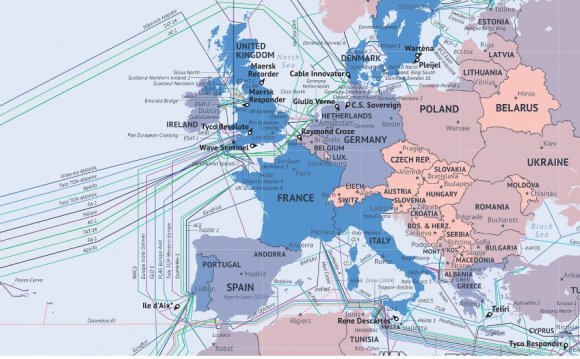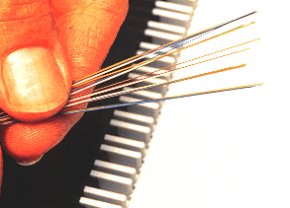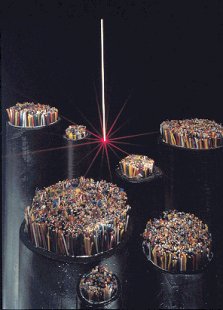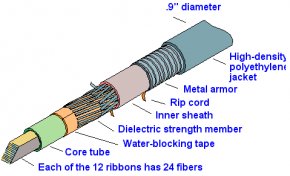
 A thin glass strand designed for light transmission. A single hair-thin fiber is capable of transmitting trillions of bits per second. In addition to their huge transmission capacity, optical fibers offer many advantages over electricity and copper wire. Light pulses are not affected by random radiation in the environment, and their error rate is significantly lower. Fibers allow longer distances to be spanned before the signal has to be regenerated by expensive "repeaters." Fibers are more secure, because taps in the line can be detected, and lastly, fiber installation is streamlined due to their dramatically lower weight and smaller size compared to copper cables. Starting in the 1970s In the late 1970s and early 1980s, telephone companies began to use fibers extensively to rebuild their communications infrastructure. According to KMI Corporation, specialists in fiber optic market research, by the end of 1990 there were approximately eight million miles of fiber laid in the U.S. (this is miles of fiber, not miles of cable which can contain many fibers). By the end of 2000, there were 80 million miles in the U.S. and 225 million worldwide. Copper cable is increasingly being replaced with fibers for LAN backbones as well, and this usage is expected to increase substantially. Pure Glass An optical fiber is constructed of a transparent core made of nearly pure silicon dioxide (SiO2), through which the light travels. The core is surrounded by a cladding layer that reflects light, guiding the light along the core. A plastic coating covers the cladding to protect the glass surface.
A thin glass strand designed for light transmission. A single hair-thin fiber is capable of transmitting trillions of bits per second. In addition to their huge transmission capacity, optical fibers offer many advantages over electricity and copper wire. Light pulses are not affected by random radiation in the environment, and their error rate is significantly lower. Fibers allow longer distances to be spanned before the signal has to be regenerated by expensive "repeaters." Fibers are more secure, because taps in the line can be detected, and lastly, fiber installation is streamlined due to their dramatically lower weight and smaller size compared to copper cables. Starting in the 1970s In the late 1970s and early 1980s, telephone companies began to use fibers extensively to rebuild their communications infrastructure. According to KMI Corporation, specialists in fiber optic market research, by the end of 1990 there were approximately eight million miles of fiber laid in the U.S. (this is miles of fiber, not miles of cable which can contain many fibers). By the end of 2000, there were 80 million miles in the U.S. and 225 million worldwide. Copper cable is increasingly being replaced with fibers for LAN backbones as well, and this usage is expected to increase substantially. Pure Glass An optical fiber is constructed of a transparent core made of nearly pure silicon dioxide (SiO2), through which the light travels. The core is surrounded by a cladding layer that reflects light, guiding the light along the core. A plastic coating covers the cladding to protect the glass surface. Cables also include fibers of Kevlar and/or steel wires for strength and an outer sheath of plastic or Teflon for protection. Enormous Bandwidth For glass fibers, there are two "optical windows" where the fiber is most transparent and efficient. The centers of these windows are 1300 nm and 1550 nm, providing approximately 18, 000 GHz and 12, 000 GHz respectively, for a total of 30, 000 GHz. This enormous bandwidth is potentially usable in one fiber. The only limitation is the electronic circuits that modulate the light waves to represent the data. Electronic ciruits have yet to come close to the frequencies of light. Plastic is also used for short-distance fiber runs, and their transparent windows are typically 650 nm and in the 750-900 nm range.
Cables also include fibers of Kevlar and/or steel wires for strength and an outer sheath of plastic or Teflon for protection. Enormous Bandwidth For glass fibers, there are two "optical windows" where the fiber is most transparent and efficient. The centers of these windows are 1300 nm and 1550 nm, providing approximately 18, 000 GHz and 12, 000 GHz respectively, for a total of 30, 000 GHz. This enormous bandwidth is potentially usable in one fiber. The only limitation is the electronic circuits that modulate the light waves to represent the data. Electronic ciruits have yet to come close to the frequencies of light. Plastic is also used for short-distance fiber runs, and their transparent windows are typically 650 nm and in the 750-900 nm range. Singlemode and Multimode There are two primary types of fiber. For intercity cabling and highest speed, singlemode fiber with a core diameter of less than 10 microns is used. Multimode fiber is very common for short distances and has a core diameter from 50 to 100 microns. See laser, WDM, fiber optics glossary and cable categories.
Singlemode and Multimode There are two primary types of fiber. For intercity cabling and highest speed, singlemode fiber with a core diameter of less than 10 microns is used. Multimode fiber is very common for short distances and has a core diameter from 50 to 100 microns. See laser, WDM, fiber optics glossary and cable categories.
Fiber Strands
The fibers in this picture are being prepared for splicing in a wiring closet. These few strands can collectively transmit trillions of bits per second. (Image courtesy of Corning Incorporated.)
Fiber Vs. Copper
Not only does optical fiber offer enormous bandwidth, but it takes a lot less room. Any one of these copper bundles can be replaced with one fiber strand (center). (Image courtesy of Corning Incorporated.)
Fiber-Optic Cable
This Lucent fiber-optic cable holds 288 fibers, which was a record-high fiber count in 1996. Cables with more than a thousand fibers have since been developed.
YOU MIGHT ALSO LIKE












